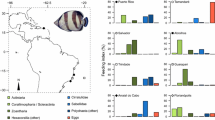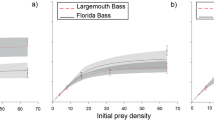Abstract
Changing environmental temperatures can impact ectotherm behavior in a number of ways, many of which can be crucial for survival. Prey capture behaviors have been shown to change with changing temperature. While temperature effects are clearly important to fishes that rely on rapid buccal expansion to create suction, less is known regarding temperature impacts on fishes that rely on biting. To understand this better, we exposed tautog (Tautoga onitis) to 10, 25, and 28 °C and recorded their feeding behaviors on sandworms and Asian shore crabs. When feeding on crabs, the only kinematic variable that differed with temperature was the time it took to capture prey. When feeding on sandworms, the only variable that differed was the velocity of gape expansion. Gape opening velocity and time to prey capture were faster when feeding on sandworms compared to crabs. Despite a 15 °C difference in our treatments, increasing temperature had a minimal impact on feeding performance. However, prey type appeared to cause a behavioral shift from suction feeding (sandworm) to biting (crab). This modulation of behavior is remarkable given the anatomical specializations tautog have to favor biting. Interestingly, the tautog’s realized trophic niche, as confirmed with gut content studies, does not match their hypothesized trophic niche based on feeding performance metrics described here.


Similar content being viewed by others
Data availability
All data can be made available upon request.
References
Alfaro ME, Janovetz J, Westneat MW (2001) Motor control across trophic strategies: muscle activity of biting and suction feeding fishes. Am Zool 41:1266–1279
Bigelow HB, Schroeder WC (1953) Bony fishes, class Osteichthyes. Cunner tribe or wrasses. Family Labridae, tautog Tautoga onitis (Linnaeus). Fishes of the Gulf of Maine. pp 478–484
Coughlin DJ, Shiels LP, Nuthakki S, Shuman JL (2016) Thermal acclimation to cold alters myosin content and contractile properties of rainbow smelt, Osmerus mordax, red muscle. Comp Biochem Physiol Part A 196:46–53
DeVries MS, Wainwright PC (2006) The effects of acute temperature change on prey capture kinematics in largemouth bass, Micropterus salmoides. Copeia 2006(3):437–444
Ferry-Graham LA (1998) Effects of prey size and mobility on prey-capture kinematics in leopard sharks Triakis semifasciata. J Exp Biol 201(16):2433–2444
Gillis G, Lauder GV (1995) Kinematics of feeding in bluegill sunfish: is there a general distinction between aquatic capture and transport behaviors? J Exp Biol 198(3):709–720
Greek-Walker M, Pull GA (1975) A survey of red and white muscle in marine fish. J Fish Biol 7(3):295–300
Hobbs RS, Shears MA, Graham LA, Davies PL, Fletcher GL (2011) Isolation and characterization of type I antifreeze proteins from cunner, Tautogolabrus adspersus, order Perciformes. FEBS J 278(19):3699–3710
James RS (2013) A review of the thermal sensitivity of the mechanics of vertebrate skeletal muscle. J Comp Physiol B 183(6):723–733
Lauder GV (1983) Prey capture hydrodynamics in fishes: experimental tests of two models. J Exp Biol 104(1):1–13
Lauder GV (2013) Aquatic feeding in lower vertebrates. Functional vertebrate morphology. Harvard University Press, England, pp 210–229
Liem KF (1980) Adaptive significance of intra- and interspecific differences in the feeding repertoires of cichlid fishes. Am Zool 20:295–314
Liem KF (2019) Functional versatility, speciation, and niche overlap: are fishes different? Trophic interactions within aquatic ecosystems. Routledge, New York, pp 269–305
Liem KF, Sanderson SL (1986) The pharyngeal jaw apparatus of labrid fishes: a functional morphological perspective. J Morphol 187(2):143–158
Moran CJ, Burgess E, Gerry SP (2021) Feeding below the thermocline: implications for prey capture kinematics. J Zool 315(1):42–48
Moran CJ, Carlowicz RM, Gerry SP (2019a) A temperate labrid fish demonstrates compensatory mechanisms to feed at torpor-inducing temperatures. J Zool 307(2):125–130
Moran CJ, Neubauer DL, Rzucidlo CL, Gerry SP (2019b) Temperature constrains locomotion and muscle function in two temperate labrids. Comp Biochem Physiol Part A 227:172–178
Moran CJ, Rzucidlo CL, Carlowicz RM, Gerry SP (2018) Stereotyped feeding behaviors of polyphenic bluegill sunfish. J Zool 305(2):116–123
Moran CJ, Rzucidlo CL, Ellerby DJ, Gerry SP (2019c) Laboratory constraints on feeding behaviours in polymorphic bluegill sunfish (Lepomis macrochirus). Freshw Biol 64(5):926–932
Muller M, Osse JWM (1984) Hydrodynamics of suction feeding in fish. Trans Zool Soc Lond 37:51–135
Norton SF, Brainerd EL (1993) Convergence in the feeding mechanics of ecomorphologically similar species in the Centrarchidae and Cichlidae. J Exp Biol 176:11–29
O’Donnell J, O’Donnell J, Fake TA (2016) Detecting climate change impacts in Long Island Sound. EPA Long Island Sound Study, pp 1–133
Olla BL, Bejda AJ, Martin AD (1974) Daily activity, movements, feeding, and seasonal occurrence in the tautog, Tautoga onitis. FishB-NOAA 72(1):27–35
Rand DM, Lauder GV (1981) Prey capture in the chain pickerel Esox niger: correlations between feeding and locomotor behavior. Can J Zool 59:1072–1078
Rome LC, Sosnicki A, Choi IH (1992) The influence of temperature on muscle function in the fast swimming scup. II. The mechanics of red muscle. J Exp Biol 163(1):281–295
Roy J (2021) Morphological diet analysis of the lumpfish (Cyclopterus lumpus): a cleaner fish inside Newfoundland salmon sea cages (Doctoral dissertation). University of Guelph)
Sidell BD, Wilson FR, Hazel J, Prosser CL (1973) Time course of thermal acclimation in goldfish. J Comp Physiol 84:119–127
Tegner MJ (1980) Multispecies considerations of resource management in southern California kelp beds. Can Tech Rep Fish Aquat Sci 954:125–143
Wainwright PC, Richard BA (1995) Predicting patterns of prey use from morphology of fishes. Environ Biol Fish 44:97–113
Wintzer AP, Motta PJ (2004) The effects of temperature on prey-capture kinematics of the bluegill (Lepomis macrochirus): implications for feeding studies. Can J Zool 82:794–799
Acknowledgements
We would like to thank David Hudson, Kamryn Jebb, Caitlin Oberempt, and Sidney Sarfo for their experimental assistance. Thank you to Michael Andreychik for his statistical advice. This research was presented at the Society for Integrative and Comparative Biology symposium “Applied Functional Biology: Linking Ecological Morphology to Conservation and Management.”
Funding
Funding for this research was provided by a Guillet Fellowship to Sidney Sarfo, the Near Center of Climate Studies at The Citadel to CJM, a Fairfield University Summer Research Stipend to SPG and NSF IOS 1354469 to SPG provided some funds for this work.
Author information
Authors and Affiliations
Corresponding author
Ethics declarations
Ethics approval
All fish were collected under CT DEEP permit SC-18005b.
Conflict of interest
The authors declare no competing interests.
Additional information
Publisher’s Note
Springer Nature remains neutral with regard to jurisdictional claims in published maps and institutional affiliations.
Rights and permissions
Springer Nature or its licensor (e.g. a society or other partner) holds exclusive rights to this article under a publishing agreement with the author(s) or other rightsholder(s); author self-archiving of the accepted manuscript version of this article is solely governed by the terms of such publishing agreement and applicable law.
About this article
Cite this article
Moran, C.J., Gerry, S.P. The impacts of temperature on feeding behaviors in tautog (Family: Labridae; Tautoga onitis). Environ Biol Fish 106, 2059–2067 (2023). https://doi.org/10.1007/s10641-023-01484-0
Received:
Accepted:
Published:
Issue Date:
DOI: https://doi.org/10.1007/s10641-023-01484-0




